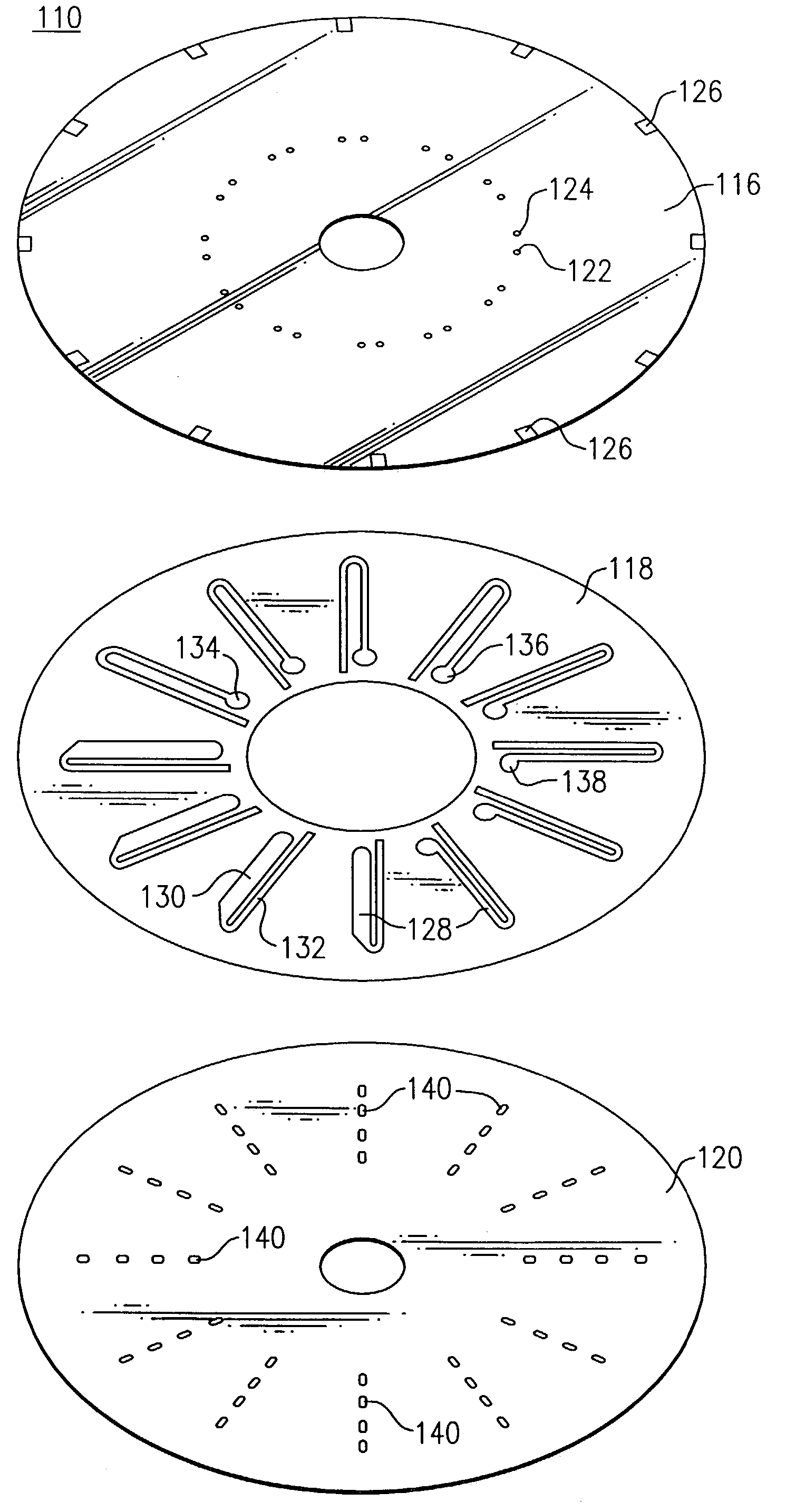Multi-purpose optical analysis disc for conducting assays and related methods for attaching capture agents
a technology of optical analysis disc and capture agent, which is applied in the direction of material analysis, instruments, nanosensors, etc., can solve the problems of expensive equipment, time-consuming and laborious, and the chips are not for the end-user to use, etc., and achieves the effect of reducing the cost of equipment, and improving the accuracy of the assay
- Summary
- Abstract
- Description
- Claims
- Application Information
AI Technical Summary
Benefits of technology
Problems solved by technology
Method used
Image
Examples
example 1
Direct Binding of Capture Antibodies on the Metal Layer
A 2 mg amount of affinity purified anti-HCG-alpha capture antibody (Biocheck, Burlingame, Calif.) was dissolved in 2% glycerol in PBS, pH 7.4 to obtain a 100 ug / ml stock solution. A pin stamper was used to directly apply multiple spots of 0.2-0.3 ul of the capture antibody stock solution on the gold metal layer (150 Angstroms thick) of the transmissive disc substrate with two concentric peripheral reservoirs as shown above in FIG. 11A. The disc was then incubated in a humid environment using a humidity chamber at room temperature overnight. After incubation, the disc was washed with a gentle stream of deionized water to remove excess unbound capture antibodies and spun dried at 1000-1500 rpm. Three absorber pads, with dimensions of the peripheral reservoir are then placed in the outer peripheral reservoir, as shown above in FIG. 13. The cap portion having attached thereto the adhesive layer, having fluidic circuits formed ther...
example 2
Purification of Microspheres
Microspheres may be purified using dialysis or centrifugation. With centrifugation, bead suspensions are centrifuged at a speed required to precipitate the particles. The speed is determined empirically and depends on the mass of the beads and the density of the buffer containing the beads [e.g., 0.2 um Fluospheres (Molecular Probes) in PBS or conjugation buffer may be centrifuged at 600 rpm for 30 mins and 0.5 um Fluospheres (Molecular Probes) in PBS may be centrifuged at 14000 rpm for 20 mins.). After the initial centrifugation of the bead suspension, the supernantant is discarded and the beads are resuspended in a conjugation buffer. The conjugation buffer is preferably a low ionic strength sodium phosphate buffer (PBS) having a pH slightly above the isoelectric point of the signal agent to be conjugated to the microspheres. The centrifugation, aspiration, and resuspension steps are repeated three times and the final pellet of beads is resuspended in...
example 3
Passive Adsorption of Signal Antibodies to 0.2 um Fluospheres
5.0 mg of purified and sonicated 0.2 um polystyrene carboxylate Fluospheres (Molecular Probes, Eugene, Oreg.), prepared as described in Example 2, were dispensed into 250 ul of 20 mM Sodium Phosphate buffer, pH 7.2 in a 1.7 ml Costar centrifuge tube. The beads were mixed in a vortex mixer and an additional 250 ul of Sodium Phosphate buffer was then added to the bead suspension. Then 250 ug of anti-HCG-beta was added to the bead suspension and immediately mixed using a vortex mixer. The tube containing the bead suspension was then placed on a Dynal mixer and rotated to 40 hours at 4 degrees Celsius shielded from light. After incubation, the beads were spun at 6000 rpm for 15 mins, the supernatant was aspirated and the pellet was resuspended with 500 ul of 20 mM Sodium Phosphate buffer, pH 7.2, sonicated for 30 seconds. After the initial washing step, the beads were further washed 3 times with 500 ul of 20 mM Sodium Phosph...
PUM
 Login to View More
Login to View More Abstract
Description
Claims
Application Information
 Login to View More
Login to View More - R&D
- Intellectual Property
- Life Sciences
- Materials
- Tech Scout
- Unparalleled Data Quality
- Higher Quality Content
- 60% Fewer Hallucinations
Browse by: Latest US Patents, China's latest patents, Technical Efficacy Thesaurus, Application Domain, Technology Topic, Popular Technical Reports.
© 2025 PatSnap. All rights reserved.Legal|Privacy policy|Modern Slavery Act Transparency Statement|Sitemap|About US| Contact US: help@patsnap.com



